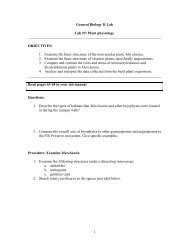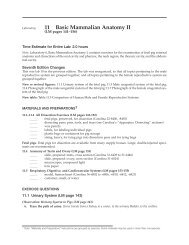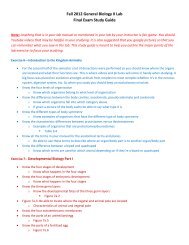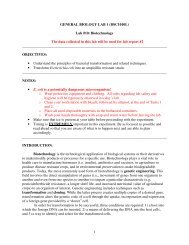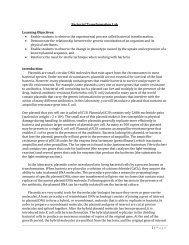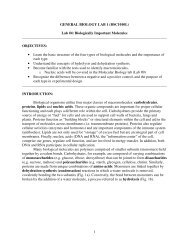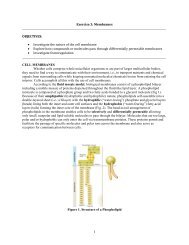Human Biology Lab Study Guide
Human Biology Lab Study Guide
Human Biology Lab Study Guide
- No tags were found...
You also want an ePaper? Increase the reach of your titles
YUMPU automatically turns print PDFs into web optimized ePapers that Google loves.
<strong>Human</strong> <strong>Biology</strong> <strong>Lab</strong> <strong>Study</strong> <strong>Guide</strong><strong>Lab</strong> 1: Metric, Microscope and Cell Structure1.1 Metric System is the standard system of measurement in the sciences. It isconvenient because all conversions between units are increments of 10.Some important prefixes:Mega (M) 10 9Kilo (k) 10 3Deca (da) 10 1Deci (d) 10 -1Centi (c) 10 -2Milli (m) 10 -3Micro (µ) 10 -6Nano (n) 10 -9Converting between different magnitudes (prefixes) requires moving the decimalpoint forward or backward corresponding to the difference between the twonumbers. The first step you must take is to ask yourself if you are convertingfrom a larger to a smaller quantity or from a smaller to a larger quantity. This willtell you if your answer will be large or small.Example: If we want to convert from 5000 m to km, you know that km are largerthan m, so your answer will be small (5).If we want to convert 50 Mm to mm, you know that Mm are far largerthan mm, so it will require many mm to equal 50 Mm (5 x 10 13 )Next, determine how far you need to move the decimal place.Example: When converting from nm to m, you must move the decimal place 9times to the right (as we are going from a small to a large quantity, our answerwill be small – it takes a lot of a small unit to equal one large)For a further explanation of the metric system, refer to page 8 of your lab manual.1.2 MicroscopyTo find differences between a compound light microscope and an electronmicroscope look on page 11 of your lab manual.Compount Light Microscopes:1) Have glass lenses2) Use visible light3) Magnify up to 2,000x4) Resolution is approximately 200 nmTransmission Electron Microscopes1) Use electromagnetic lenses2) Use beam of electrons for illumination3) Resolution is approximately 0.1 nm4) Magnify to 1,000,000x1.3 Use of the Compound Light Microscope
The list of microscope parts and directions for focusing the microscope are onpage 15 of your lab manual.Inversion – the image in a microscope is upside down and reversed.To find the true magnification of a microscope, multiply magnification of theobjective and ocular lenses.Example: If your ocular lens is 40x and the objective lens is 100x, the overallmagnification is 40x100, or 4000x.1.4 Microscopic ObservationsAnimal vs. Plant cells.1) Animal cells have a plasma membrane while plant cells have a cell wall.2) Plant cells have chloroplasts to obtain energy from the sun while animalcells do not.3) Plant cells are rigidly stacked together while animal cells do not have ahigh level of organization.1.5 Animal Cell StructureA list of organelles in an animal cell is found on page 35 of your lab book.1.6 The plasma membraneTonicityIsotonic – Same amount of solutes inside and outside of the plasmamembrane. The potato remains the same as before it was placed in solution.Hypotonic – More solutes inside membrane, water rushes in to equilibrateconcentrations and the cell swells. In our case, the potato becomes very rigidfrom higher water concentration.Hypertonic – More solutes outside the membrane, water rushes out toequilibrate concentrations and cell shrivels. The potato becomes very flaccidand weak.For more information, turn to page 38 of your lab manual.If we were to place red blood cells in a…Hypotonic solution – water would rush in to the blood cells and burst(hemolysis) making in possible to see through the test tube.Hypertonic solution – water would rush out of the blood cells and shrivelthem, but not to the point that the test tube would be clear.Isotonic solution – the cells would be in equilibrium with theirsurrounding environment, causing no change and making it impossible to seethrough the test tube.For more information, refer to page 39 of your lab manual.



